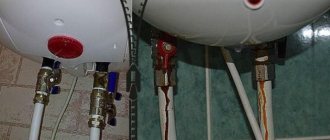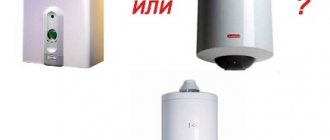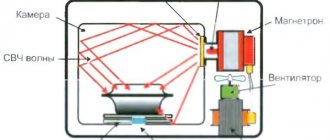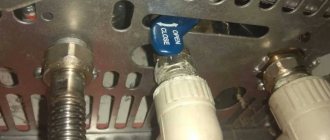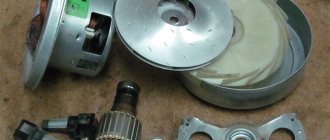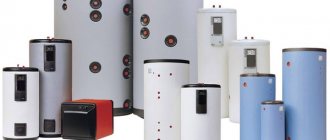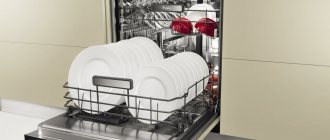Boiler advantages
Hot water in the house is not a luxury at all, but a necessary condition for comfort. However, residents of city apartments often face the fact that during the summer, hot water is disconnected from the centralized supply for repair work. This forces many people to install boilers - containers that allow water to be heated and used in the local water supply.
The advantage of heaters of this type is that they can be installed in almost any, even the smallest room. Modern models consume little electricity, which saves the family budget. And the most important plus is that there will always be a supply of hot water in the house.
Such devices are quite simple to operate, but if used irregularly, you may forget how to turn on the boiler correctly. The scheme is the same for most models. And provided that a certain sequence of all actions is followed, the water heater will serve its owner for a long time. You can turn it on yourself if you have instructions, or you can seek help from a specialist.
How to turn on the boiler?
When it is already installed and connected to the water supply system, you need to do a test run and check the operation of the boiler. In fact, there should not be any difficulties with this and the process itself does not require any special skills.
First of all, you need to turn off the valve for the centralized hot water supply to the apartment. This will prevent heated water from flowing into the common riser. Otherwise, all residents of the entrance will use water from the boiler. The manipulation is also carried out if there is a check valve.
Almost all heater models on the market (Thermex, Timberk, Electrolux, Ariston and others) are switched on in the same way.
Sequencing
It’s worth mentioning right away that the startup sequence below is correct for both flow-through and storage heaters . A couple of nuances - in the case of the first type, you do not have to wait for the tank to be filled with water and close the tap at the 2nd point.
- You should start by turning off the hot water supply , which comes from the city supply system. If you skip this step, the water heated by the boiler will go into the common riser, despite the check valve.
- Open the hot water tap . We wait until the remaining liquid drains from the pipes. Close the tap.
- Two pipes go to the bottom of the boiler. One, marked with a blue ring, is underwater, the other, with a red marker, serves to supply hot water to the pipes .
- Open the valve on the underwater pipe . Water begins to flow into the device’s storage tank.
- Next, unscrew the second valve on the boiler . Allowing the water to escape into the pipes.
- Open hot water on the mixer . We wait until the air leaves the system and a steady stream of water flows. We turn off the water.
- We connect the heater to the electrical network and set the desired temperature.
In a house where there is no hot water supply, the first step must be skipped. Subsequent switching on of the heater will follow the same pattern. The only difference is in point 6. Then not air, but stagnant water will begin to come out of the heater tank.
Heating mode selection
Set the heating mode. The main thing in this matter is to set the water temperature that is comfortable for the user . However, here are a few tips, the implementation of which will significantly extend the service life of the device. This will save you money on future repairs.
- Set the temperature to 30–40 degrees as little as possible . Under such conditions, bacteria will quickly develop inside the storage tank. This will result in an unpleasant musty odor. The walls will become covered with fungus, which is difficult to remove.
- Optimal operating mode, 55–60 degrees . In this temperature range, less scale will form on the heating element. The risk of mold will be reduced. It is comfortable for human skin.
- Once a week the boiler must be set to 90 degrees . Wait a couple of hours and return to the previous mode. This is done to completely destroy bacteria in the storage tank.
- Some devices have an economical operating mode. In this case, the heater does not consume less electricity. The settings will be set as in point 2 and we are talking about reducing the risk of breakdown.
- In the case of a flow-type heater, the temperature is also adjusted by water pressure.
Procedure
How to turn on the boiler so that hot water appears? To do this, you must perform the steps listed below in the following order:
- Open the hot water tap on the mixer and make sure there is no hot water. Close the tap.
- Open the tap with a blue circle at the inlet of the water heater, then the tap at the outlet, marked with a red mark. Wait a while until all the air leaves the system if there is no water in the boiler. Next comes the process of filling the water heater.
- If the boiler was filled with water, you only need to drain it a little and close the tap with the red circle.
- Before plugging in the boiler, you must completely fill the tank with water. Otherwise, there is a risk of the tubular heater burning out if the model is not equipped with a protection system.
- During the process of heating water, it is important to control the temperature indicator and the voltage supply to the heating element.
Experts advise setting the operating temperature of the device at 55-60° C. This will help avoid the development of fungi and bacteria in the tank, and also prevent the formation of scale on the heating element.
How to use the boiler?
After the unit has gone through the first start-up procedure, you need to let it warm up the water to the maximum temperature. Open the tap on the mixer and make sure that hot water flows from there, and then carefully inspect everything for leaks. If everything is in order, then you can start using it. The first thing you need to do in order to use the boiler correctly is to study the manufacturer’s instructions.
Turn on the unit and set the desired hot water temperature. On most heaters, manufacturers provide 3 positions: 35, 55-57 and 75 ºС. Some models also have a fourth position – “anti-freeze”, then the temperature in the tank is maintained at 10 ºС. The actual operation is to set the temperature regulator to the desired position and use water. In this case, it is worth following these recommendations:
- never turn on the boiler if for some reason the unit’s tank is empty, this can lead to failure of the heating element. The inlet safety valve has a built-in check valve; its performance must be checked at least once a year;
- Although the boiler temperature is adjusted according to your wishes, you need to turn it on to maximum once every 2 weeks and maintain this mode for 2 hours. This is necessary so that harmful bacteria living in warm water do not multiply in the tank;
- There should be a strainer at the cold water inlet into the house. If the water is hard, then it is necessary to organize additional cleaning and desalting, otherwise all heating equipment, including the boiler, will not last long;
- Once every 2 years, clean the tank from scale, and also check the condition of the protective magnesium anode and, if necessary, change it.
Using an electric instantaneous water heater is also quite simple. The device turns on immediately after opening the tap, the water temperature is regulated by decreasing and increasing the pressure. When the water runs too hot, the pressure must be increased; if it is cold, then decrease. For these devices, water hardness is also important; the presence of a large amount of salts will cause scale inside the heating element. First, the heating intensity will drop, and then the element will fail.
Features of operation of flow models
To make the boiler work longer, it is recommended to install a filter on the incoming pipe.
Differences in different types of devices determine the operating characteristics. Before starting use, you need to study the instructions from the manufacturer and perform the following steps:
- Install a coarse filter. It will allow you to collect small debris that comes from water pipes.
- Carry out horizontal installation. Only this type of installation is allowed so that there are no air pockets. The check is carried out using a building level.
- If the device is electrical, it must be grounded.
Flow models come with manual and electronic control. The first option is reliable and low cost. Electronic mechanisms are more expensive, but they expand functionality.
Before turning on the flow-through heater for the first time, it is necessary to set the optimal water temperature. It can be adjusted by buttons or by the tap itself, depending on the fluid flow. These types of water heaters can only be used at positive temperatures.
The device should be inspected periodically for damage. It is prohibited to use a faulty heater. If the device is no longer needed to heat water, it must be removed from the wall, after first unplugging it from the network and removing any remaining water. The water heater should be stored in a warm room in winter.
Features of operation of storage boilers
Storage boiler device with heating element
Models with a water tank vary in size. Larger units are usually wall-mounted or floor-mounted. There are vertical and horizontal types.
Only a device that is correctly configured and connected to the network can be turned on and used. The work must be carried out by a specialist. He also marks the quality of equipment installation.
After installation, you can use the boiler. Before the first start-up, you need to visually inspect it and ensure the integrity of the housing and wires. After a successful test, you need to fill the tank with water. To do this, open the water supply valve.
When the tank is full, you can plug in the device and press the power button. Control is carried out using buttons on the body or by entering commands on the monitor.
If the boiler is the main source of water, there is no need to disconnect it from the network. A thermostat should be installed so that the heater only operates when necessary. When the set temperature is reached, the device will automatically turn off.
How do I turn on hot water again?
Boilers are used mainly in the summer, when interruptions in hot water supply often occur. If heating with a heater is no longer necessary, it is important to know how to turn off the boiler and turn on hot water from a centralized system. The process may take slightly longer than when connecting the unit.
First of all, the device is disconnected from the power supply. Some experts do not recommend storing the water remaining in the tank, while others, on the contrary, say that this way the parts will be less susceptible to corrosion. If water still remains in the tank, it must be drained before turning on the boiler next time.
It is imperative to shut off the cold water supply to the heater system (tap with a blue circle). After this, the heated liquid outlet valve is closed. The final stage is to turn on the hot water on the mixer.
Operation of an already operating boiler
It is worth noting that during operation the device should never be disconnected from the network. This can only be done in cases where hot water is not needed for some time. At the same time, experienced people say: if hot water is constantly present in the boiler, it will be less susceptible to corrosion. And setting the required temperature is much easier than heating water from scratch.
You may be interested in information on how to choose a water heater
If the tap water has increased hardness, then it is advisable to install a filter in front of the boiler. If you install the device in places with high humidity (bathhouse, sauna, etc.), carefully ensure that droplets of water do not fall on it.
Flow-through boilers differ from storage boilers in the absence of any restrictions on the amount of hot water. Such devices are often installed in only one place (in which they take a shower or wash dishes). But note that when the tap is fully opened, the water simply will not have time to heat up. To reduce heat loss, it is advisable to install the water heater as close as possible to the point of water use.
Prevention of a flow-through boiler
Note! The use of instantaneous boilers is strictly prohibited in rooms where the temperature can drop to zero degrees.
Recommendations
The water heater is dismantled only after the water has been completely drained from the tank. To do this, disconnect the cold water supply hose to the boiler, and in its place put on a pipe through which the remaining liquid will come out.
During periods when there is no need to operate the boiler, preventative maintenance of the device is carried out: the heating element is cleaned of scale, the presence of a coating inside the tank with a magnesium anode is determined (corrosion protection). It is best to do this once a year (on your own or call a professional) in order to extend the life of the water heater.
